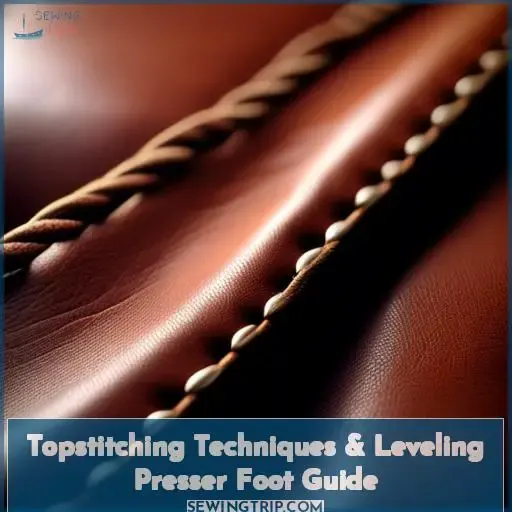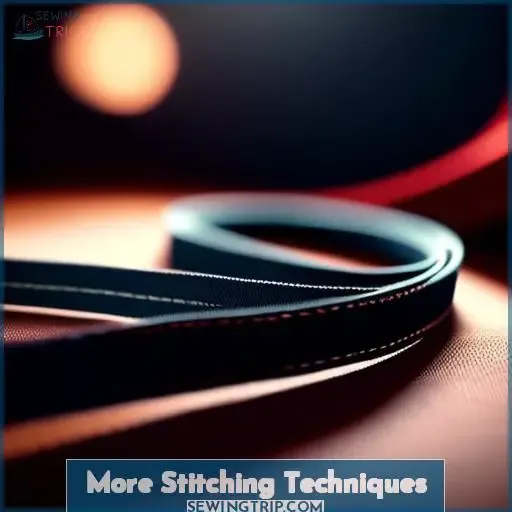This site is supported by our readers. We may earn a commission, at no cost to you, if you purchase through links.
 Investigate the truth behind topstitching, a technique that elevates your sewing projects from homemade to professionally crafted.
Investigate the truth behind topstitching, a technique that elevates your sewing projects from homemade to professionally crafted.
In this guide, you’ll master the art of topstitching, learning to add both strength and decorative flair to your creations.
You’ll also discover the leveling presser foot, an ingenious tool that ensures smooth, even stitches across thick seams.
Embrace these skills to transform your work with precision and style, satisfying your innate desire for craftsmanship and innovation.
Table Of Contents
Key Takeaways
Topstitching is a versatile technique that can be used for both functional purposes, such as adding durability and strength to seams, and decorative purposes, like creating visual interest or intricate patterns through decorative stitching and machine embroidery.
The choice of thread color in topstitching plays a significant role, with contrasting colors adding drama and visibility to the stitching, while matching colors can create a more subtle, stealthy appearance.
Proper tools and adjustments, such as using a leveling presser foot, can enhance sewing precision by ensuring smooth fabric gliding, adjusting foot pressure and height to accommodate different fabric thicknesses, and preventing puckering and uneven stitching.
Topstitching is highly prevalent in ready-to-wear garments, with approximately 80% of them featuring topstitching, showcasing its importance in adding a professional finish, showcasing skill, and elevating the appearance of homemade projects.
What is Topstitching
Topstitching refers to a sewing technique where a line of stitching is made visible on the outside of a garment, often for decorative or functional purposes. This method is commonly used on edges like necklines and hems to add detail or reinforce the garment.
More Stitching Techniques
Topstitching is an art form where every stitch serves as a brushstroke on your fabric canvas. It consists of several key techniques, each playing a unique role in enhancing the appearance and durability of your sewing projects.
Stay Stitching
This quiet yet essential technique holds curves in check. By stitching along the seam line of curved edges, stay stitching prevents distortion during pressing and subsequent sewing steps.
Understitching
Acting as a loyal sidekick, understitching keeps linings from peeking out. This process involves stitching the lining to the seam allowance, creating a clean finish on the wrong side of the garment.
Raw Edge Finishing
Raw edge finishing is the knight in shining armor, protecting your fabric from the fray dragon. Using techniques such as zigzag stitching, pinking, or serging, you can prevent fraying and extend the life of your projects.
Decorative Stitching and Machine Embroidery
These techniques are the show-offs, flaunting their flair with every loop and swirl. Decorative stitching adds visual interest to hems, pockets, and other design elements, while machine embroidery allows for intricate patterns and monograms.
To master topstitching, grab your topstitch thread and dance with your topstitch foot across the material. Each stitch is a step in your sewing story—make it captivating, make it sing, and sometimes, make it wink.
Leveling Presser Foot
When you’re diving into the art of sewing, mastering the leveling presser foot can feel like you’re unlocking a secret level in a video game.
Think of your presser foot as the unsung hero of your sewing machine, quietly ensuring your fabric glides smoothly under the needle.
Adjusting the foot pressure and height isn’t just about keeping things even; it’s about fine-tuning your machine to handle the fabric’s mood swings.
Whether it’s a thick denim or a slippery silk, the right presser foot alignment can make or break your project.
So, grab those presser foot accessories, tweak that foot level gauge, and remember: a well-adjusted presser foot is the secret handshake between your fabric and needle.
Frequently Asked Questions (FAQs)
Can topstitching be done on stretchy fabrics?
Yes, you can topstitch stretchy fabrics by using a walking foot, stabilizer, and stretch stitches to prevent puckering and ensure the stitching stretches with the fabric.
How do I prevent topstitch thread from tangling?
To dodge the dreaded tangle, treat your topstitch thread like a delicate dance partner—gently guide it, avoiding any tension missteps, and let it twirl freely to prevent any unwanted knots.
Is topstitching suitable for all types of seams?
Topstitching isn’t a one-size-fits-all; it’s ace for adding durability and flair to many seams but might be overkill on delicate fabrics where subtlety’s the name of the game.
What alternatives exist for topstitching on delicate fabrics?
For delicate fabrics, consider understitching, hand prickstitching, or using fusible interfacing to avoid the potential pitfalls of topstitching, like puckering or unwanted shine.
How to choose the right color for topstitching thread?
Choosing your topstitching thread color? Think contrast for drama or match for stealth. Like a chameleon in a yarn shop, pick hues that either pop or blend. It’s your fabric’s chance to whisper or shout.
Conclusion
Nearly 80% of ready-to-wear garments feature topstitching, a testament to its dual role in aesthetics and function.
You’ve learned that topstitching isn’t just for looks; it adds durability and structure to your sewing projects.
With the leveling presser foot, you can conquer bulky seams with ease, ensuring your stitches lie flat and even.
Embrace these techniques to give your creations that sought-after professional finish, showcasing your skill and attention to detail.







